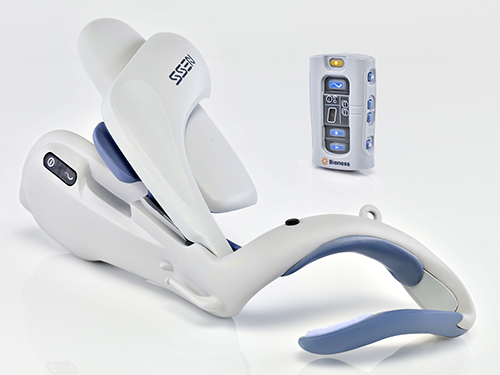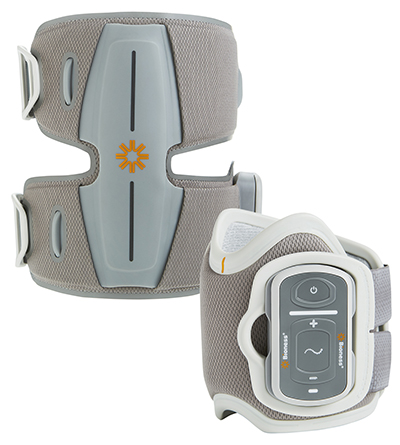Lightweight Neuroprosthesis Helps CNS Patients Regain Mobility
North Kansas City Hospital is the only hospital in the Northland to offer an innovative treatment to help patients regain lower extremity and hand function caused by brain or spinal cord injury, multiple sclerosis, stroke or other central nervous system disorders. Called functional electrical stimulation, the neuroprosthesis devices help reduce impairments and increase daily functional activities in upper and lower extremities.
Adaptive Technology
The lightweight devices, developed by Bioness®, have adaptive technology that wirelessly provides low-level electrical stimulation that mimics natural electrical brain signals to activate nerves and muscles. A therapist uses a hand-held remote control to adjust and tailor the stimulation to each patient.
“We’re always working toward helping our patients make motor and functional gains,” said Adam J. Schulte, MD, opens new tab, a physical medicine and rehabilitation physician and associate medical director of NKCH’s Acute Inpatient Rehabilitation Unit. “This device actually stimulates the nerves and muscles to work together so patients can regain more normal hand or leg use and achieve more independence for a better quality of life. Our patients have been very happy with the therapies because they see day-to-day improvements.”
Functional Gains

The functional electrical stimulation of the upper device helps people living with hand paralysis
regain function and freedom.
The hand device, which fits to the forearm and wrist, stimulates nerves and muscles so patients can open and close the hand in a functional grasp pattern. Five electrodes deliver electrical stimulation to muscles that control hand function. The device helps restore lost functional activities, such as grasping, releasing, and opening and closing the hand. For some patients, it also may assist in reducing secondary paresis issues, such as poor blood circulation, limited range of motion, muscle atrophy, spasms and hypersensitivity.

The lower extremity system delivers electrical stimulation in a precise
sequence that activates muscles to lift the foot to take a step. It also
automatically adjusts to changes in walking speed and terrain.
The lower extremity system, which fits below the knee, senses where the patient’s leg is in the gait cycle. It delivers electrical stimulation in a precise sequence, that activates muscles to lift the foot to take a step. The system can automatically adjust to changes in walking speed and terrain. It helps patients walk more naturally, with increased speed and improved balance, including on carpet and steps. For some, it may prevent or reduce muscle atrophy, help maintain and increase joint range of motion, and increase blood flow.
“An occupational or physical therapist is integral for the patient to have success,” Dr. Schulte said. “For example, in sessions with a patient who has foot drop, the physical therapist works with the patient on standing or walking with different measures of improvement, such as speed and distance.”
Dr. Schulte added that while FES is intended for patients with central nervous system injuries or diseases that cause motor deficits, some patients are not candidates and instead require a stable orthotic. This includes patients who have a:
- Lower motor neuron injury or disease
- Pacemaker, defibrillator, or any electrical or metal implant
- Wound where the device would be placed
|
Effects of AFO and Functional Electrical System Stimulation on Gait |
|||
|---|---|---|---|
| Measure | AFO | Neuroprosthesis Adaptation | Neuroprosthesis Postadaptation |
| 6-Min. Walk Gait Speed (m/s) | 0.58 ± 0.06 | 0.61 ± 0.06 (.953) | 0.67 ± 0.06 (.142) |
| Average Stride Time(s) | 1.48 ± 0.21 | 1.47 ± 0.18 (.971) | 1.41 ± 0.16 (.022) |
| Swing Time Variability, Nonparetic Leg (%) | 5.3 ± 1.6 | 5.1 ± 2.0 (.436) | 4.3 ± 1.4 (.009) |
| Swing Asymmetry | 0.20 ± 0.09 | 0.19 ± 0.09 (.406) | 0.17 ± 0.08 (.048) |
|
P values in parentheses show results of comparison with AFO at 4 weeks. |
|||
|
Source: Journal of Stroke Cerebrovascular Disease, January-February 2009 |
|||
Research
Several studies have shown the advantages of FES versus a stable orthotic. In “Neuroprosthesis for Foot Drop Compared With Ankle-Foot Orthosis: Effects on Postural Control During Walking,” published in the January-February 2009 Journal of Stroke Cerebrovascular Disease, opens new tab, researchers compared functional electrical system stimulation and a standard ankle-foot orthotic on gait stability and symmetry. They enrolled 15 patients with prior chronic hemiparesis caused by stroke or a traumatic brain injury and who regularly used an AFO to assist with foot drop.
During the study, participants increased their daily FES use over a four-week adaptation period, while using an AFO the rest of the day. They were asked to gradually increase the use of the neuroprosthesis to an hour and up to four hours by the end of the first week and second week, respectively.
By the end of the fourth week, patients could use the neuroprosthesis up to six hours. Investigators assessed gait in a 6-minute walk by having patients wear force-sensitive insoles when using the FES and AFO in random order. For an additional four weeks, patients wore an FES only. Investigators found enhanced balance control during walking and more effectively managed foot drop (see table).
Adam J. Schulte, MD
 Dr. Schulte, opens new tab earned his medical degree from Saint Louis University and completed his residency in rehabilitative medicine at Washington University.
Dr. Schulte, opens new tab earned his medical degree from Saint Louis University and completed his residency in rehabilitative medicine at Washington University.